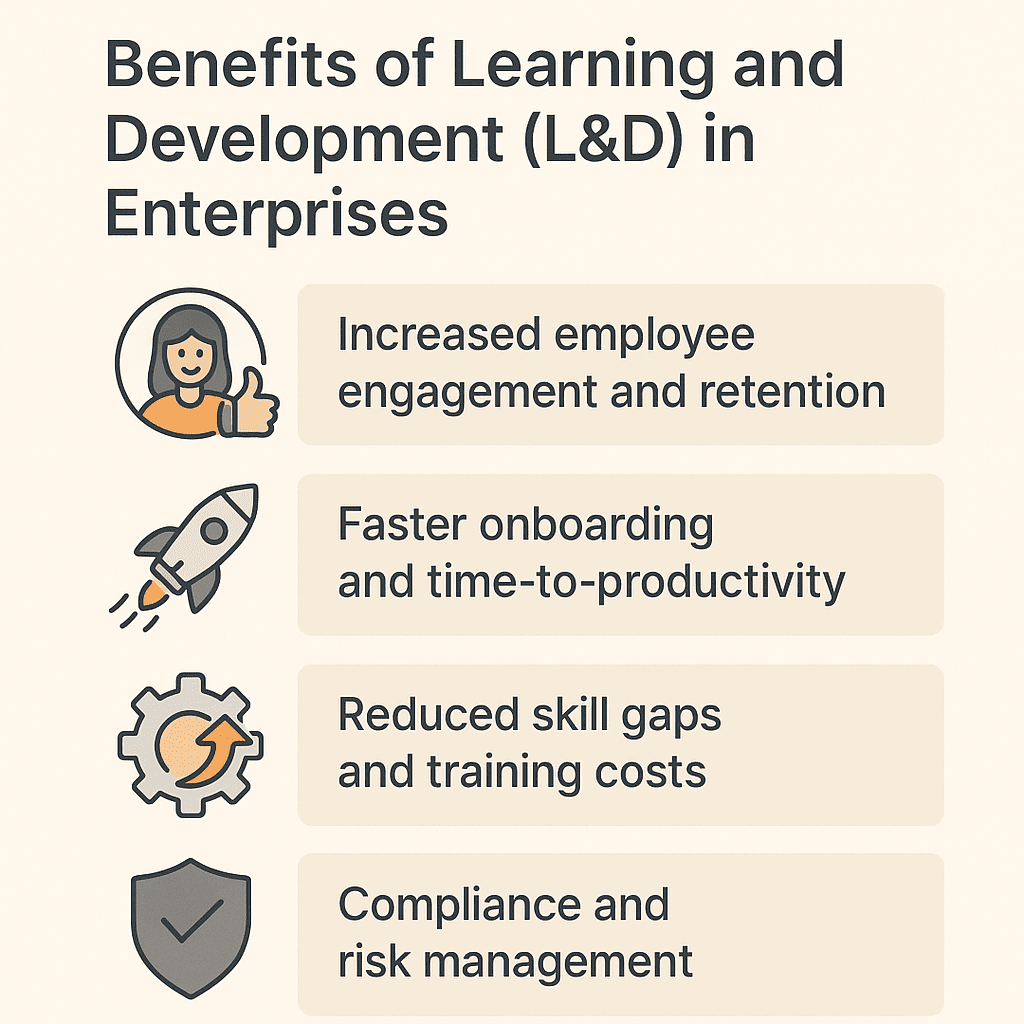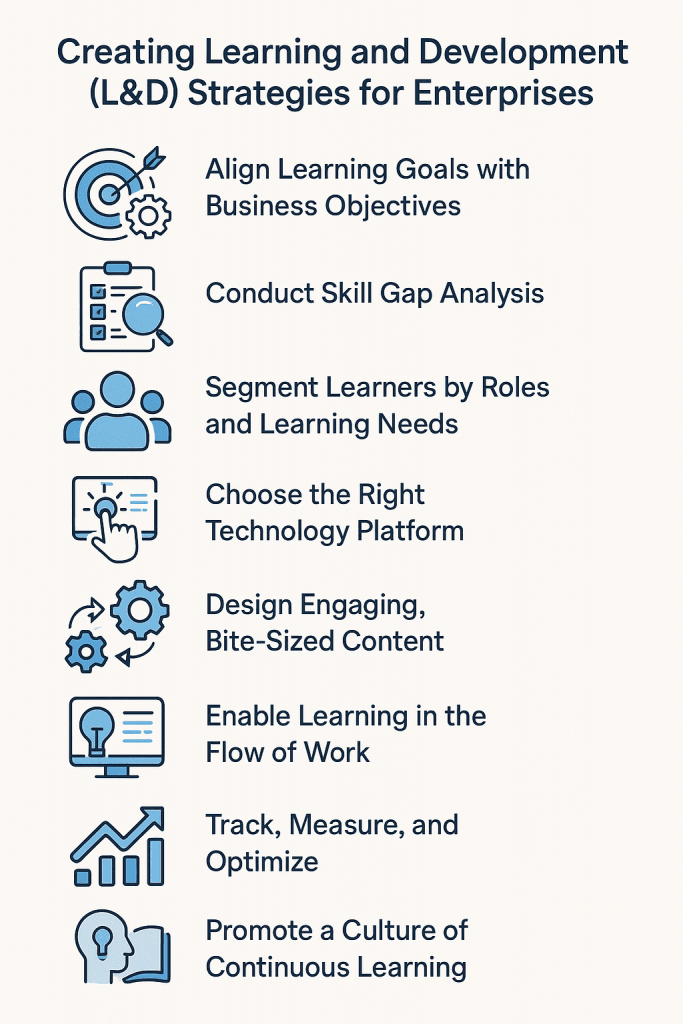In today’s fast-paced, digitally driven business landscape, Learning and Development (L&D) is no longer a support function, it is a strategic enabler of enterprise agility, innovation, and talent retention. At its core, L&D refers to the continuous process of empowering employees with the knowledge, skills, and capabilities they need to succeed in their current roles and grow into future opportunities. It encompasses everything from onboarding and technical training to leadership development, coaching, and reskilling programs.
For modern enterprises, L&D is critical not just for workforce preparedness, but also for building a resilient, future-ready organization. A well-structured L&D strategy ensures that employees remain aligned with business goals, are motivated to grow, and are equipped to tackle challenges in real time.
But here’s the reality: the world of work is undergoing rapid transformation, and traditional learning approaches are no longer sufficient. Digital disruption, automation, evolving customer expectations, and hybrid work environments have all redefined the way employees learn, and what they need to learn.
The Answer to the Skills Crisis Lies in Learning
According to LinkedIn’s 2024 Workplace Learning Report:
Nearly half of learning and talent development professionals (49%) say, “My executives are concerned that employees do not have the right skills to execute our business strategy.”
This concern points directly to a growing skills crisis in the workforce. In a world of constant change, organizations are only as adaptable as their people, and their skills. That’s where modern L&D plays a pivotal role.
But learning alone isn’t enough. The research also reveals that career development, when integrated with learning, such as through coaching, leadership training, and internal mobility, dramatically accelerates the development of critical skills and strengthens workforce adaptability.
Why is career development such a powerful driver of resilience and loyalty?
Because career progress is the #1 reason people choose to learn. When growth opportunities stall, employees leave, and they take their skills and potential with them. On the flip side, companies that invest in structured learning and career growth build energy, innovation, and loyalty for the long haul.
“Great companies are built on great careers.”
L&D Is a High-Growth, High-Investment Industry
Global market trends from Statista further reinforce the rising importance of enterprise learning:
- The global workplace training industry is expected to reach $401 billion in 2024, marking sustained growth since 2009.
- In the U.S. alone, corporate training expenditures reached $102 billion in 2023, a significant investment in reskilling and upskilling the workforce.
- Reskilling priorities are now heavily focused on analytical thinking, AI, and big data, signaling a strategic shift toward tech-powered capabilities.
This surge in L&D spending underscores a worldwide recognition: continuous learning is essential for business resilience, digital transformation, and sustainable growth.
Understanding What is Learning and Development in the Enterprise Context
Enterprise L&D is the strategic process of continuously upskilling and reskilling employees to align with the organization’s evolving goals. It goes beyond onboarding or compliance, it’s about building a learning culture that fuels innovation, productivity, and employee growth.
Modern L&D includes:
- Role-based training and upskilling
- Leadership development programs
- Cross-functional mobility and reskilling
- Digital learning platforms for continuous learning
Beetsol LMS supports all of the above with intelligent automation, content recommendations, and progress tracking, ensuring learning is always aligned with organizational needs.
Why Enterprise L&D Is Crucial for Long-Term Talent Sustainability
The current skills crisis isn’t just about hiring gaps, it’s about retaining and evolving your existing workforce. LinkedIn’s data shows that career development is the main reason employees choose to learn. When companies don’t invest in learning pathways, they risk high attrition and skill drain.
A forward-looking enterprise L&D strategy helps:
- Retain top talent through career mobility
- Foster a culture of adaptability and curiosity
- Reduce recruitment costs through internal growth
- Counteract uncertainty with upskilled, confident teams
Strategic Benefits of L&D for Large Organizations

Investing in learning is investing in business continuity. Organizations that embed L&D into their culture experience tangible benefits such as:
1. Increased employee engagement and retention
Beetsol LMS empowers learners with personalized journeys, increasing participation and reducing learning fatigue.
2. Faster onboarding and time-to-productivity
With Beetsol’s role-based learning paths, new hires hit the ground running, up to 40% faster.
3. Reduced skill gaps and training costs
Our AI recommendations reduce time spent designing training programs, focusing instead on what works.
4. Compliance and risk management
Automate tracking of mandatory training, certificates, and assessments.
Building a Future-Ready Enterprise Learning Framework
Creating a scalable, intelligent L&D strategy involves more than just uploading training videos. It requires an ecosystem mindset. Here’s how Beetsol helps enterprise clients lay the foundation:
1. Needs Analysis with Skill Gap Insights
AI analyzes organizational skill trends and pinpoints gaps across roles or departments.
2. AI-Curated Learning Journeys
Personalized learning paths adapt based on learner behavior, job function, and performance metrics.
3. Integrated Career Development Tools
Employees can view career pathways, required skills, and track progress, all within the platform.
4. Real-Time Analytics and Feedback Loops
HR leaders get dashboards for content effectiveness, learner progress, and skill impact.
How AI is Transforming Enterprise Learning
AI in L&D is more than a buzzword, it’s a game changer. With machine learning and natural language processing, Beetsol platform automates and enhances every aspect of the learning journey:
- Predictive learning paths tailored to individual goals and roles
- Auto-tagging and indexing of content using AI
- Smart recommendations that evolve as learners grow
- Microlearning modules delivered in the flow of work
- Chatbot tutors and adaptive quizzes for continuous reinforcement
Real scenario:
A telecom enterprise used Beetsol LMS to reskill 3,000+ employees across 10 departments. With AI-curated paths and integrated coaching tools, they reduced external hiring by 22% within one year.
Enterprise Learning in Action: L&D Program Examples
Here are real-world learning programs made more effective with Beetsol:
- Leadership Development: Coaching modules and simulations for high-potential employees.
- Customer Service Training: Interactive role-plays and KPI-aligned skill tracking.
- Sales Enablement: Bite-sized, mobile-friendly content to train field reps on new products.
- Compliance Training: Automated scheduling and audit trails to meet industry regulations.
Creating a Modern L&D Strategy: Key Steps

A future-ready learning and development strategy should be intentional, scalable, and closely tied to business outcomes. Here are the essential steps to design a high-impact enterprise L&D program:
1. Align Learning Goals with Business Objectives
Start by identifying the organization’s strategic priorities and translating them into learning outcomes. Ensure that every training initiative supports a measurable business goal, be it increasing sales performance, improving customer service, or driving digital transformation.
2. Conduct Skill Gap Analysis
Use performance data, employee feedback, and AI-powered insights to map current skills against future needs. This helps prioritize training for the most critical areas and tailor content to fill the most urgent gaps.
3. Segment Learners by Roles and Learning Needs
Not all employees learn the same way. Group learners based on roles, functions, or career levels to create targeted and relevant learning paths. Personalized content boosts engagement and knowledge retention.
4. Choose the Right Technology Platform
Select a robust LMS like Beetsol, which supports AI-driven personalization, mobile learning, integration with work tools (Slack, Teams, CRM), and real-time analytics to track progress and impact.
5. Design Engaging, Bite-Sized Content
Keep learners motivated with interactive, modular, and easily digestible content. Include formats like videos, simulations, quizzes, and scenario-based learning to reinforce knowledge effectively.
6. Enable Learning in the Flow of Work
Integrate learning into daily tools and workflows so employees can access relevant training without stepping away from their job. This reduces disruption and encourages continuous upskilling.
7. Track, Measure, and Optimize
Use analytics to evaluate learner progress, course completion rates, and performance improvements. Adjust content and strategy based on what’s working, and what’s not, to maximize ROI.
8. Promote a Culture of Continuous Learning
Encourage managers to support team learning, recognize growth achievements, and make learning part of performance reviews. When learning is culturally embedded, it becomes a shared responsibility.
Essential Skills for L&D Leaders in 2025 and Beyond
To lead L&D in modern enterprises, professionals need more than instructional design experience. The new L&D skillset includes:
1. Data Literacy for Measuring Learning Impact
L&D leaders must be able to interpret learning analytics to demonstrate ROI, learner progress, and skill development. This enables data-driven decisions and continuous program optimization.
2. Familiarity with AI and Automation in Training Tools
Understanding how AI personalizes learning and automates delivery is essential for scaling L&D programs efficiently. Leaders should know how to leverage tools like Beetsol LMS to boost engagement and impact.
3. Stakeholder Management and Change Enablement
Successful L&D requires strong collaboration with HR, department heads, and executives. Leaders must align learning strategies with business goals and drive adoption across the organization.
4. Content Strategy and Storytelling
Beyond course creation, leaders must design compelling narratives that connect learning to real-world outcomes. Story-driven content improves knowledge retention and emotional engagement.
5. Agile Mindset and Tech Adoption
In a fast-changing environment, L&D professionals must be quick to pivot, test, and implement new tools. Embracing agile methodologies allows teams to deliver learning faster and more effectively.
Beetsol’s LMS gives L&D leaders the tools they need to build smart, scalable programs, not just content repositories.
Emerging Trends Reshaping the L&D Landscape
To stay competitive, enterprises must adapt their learning strategies to align with evolving workforce needs and technological advancements. These emerging trends are defining the future of enterprise L&D:
1. Skills-Based Learning Over Roles-Based Learning
Organizations are shifting focus from job titles to the specific skills required for business agility. This approach enables more targeted upskilling, cross-functional mobility, and future-proof workforce planning.
2. Learning in the Flow of Work via Salesforce and CRM Integrations
Modern learners prefer training that’s embedded in their daily tools and tasks. Integrating L&D into platforms like Salesforce reduces friction and boosts knowledge application on the job.
3. AI-Driven Personalization and Skill Forecasting
AI is making it possible to deliver personalized learning paths that evolve with each employee’s goals, performance, and preferences. Predictive insights help L&D leaders prepare for future skill needs proactively.
4. Internal Talent Marketplaces and Career Mobility
Forward-thinking companies are building platforms where employees can explore projects, gigs, or roles based on their skills. This not only boosts engagement but also accelerates internal movement and retention.
5. Focus on Soft Skills Like Emotional Intelligence and Collaboration
As automation rises, human-centric skills are becoming more valuable. L&D programs are increasingly prioritizing empathy, adaptability, and teamwork to support effective leadership and collaboration.
Beetsol is built with these trends in mind, enabling future-proof learning experiences today.
Let’s reimagine learning and development
As business strategies evolve, so must your workforce. The best companies aren’t just hiring skills, they’re growing them from within. By integrating AI, personalization, and strategy-driven learning journeys, Beetsol empowers enterprises to build the workforce of tomorrow, today.
